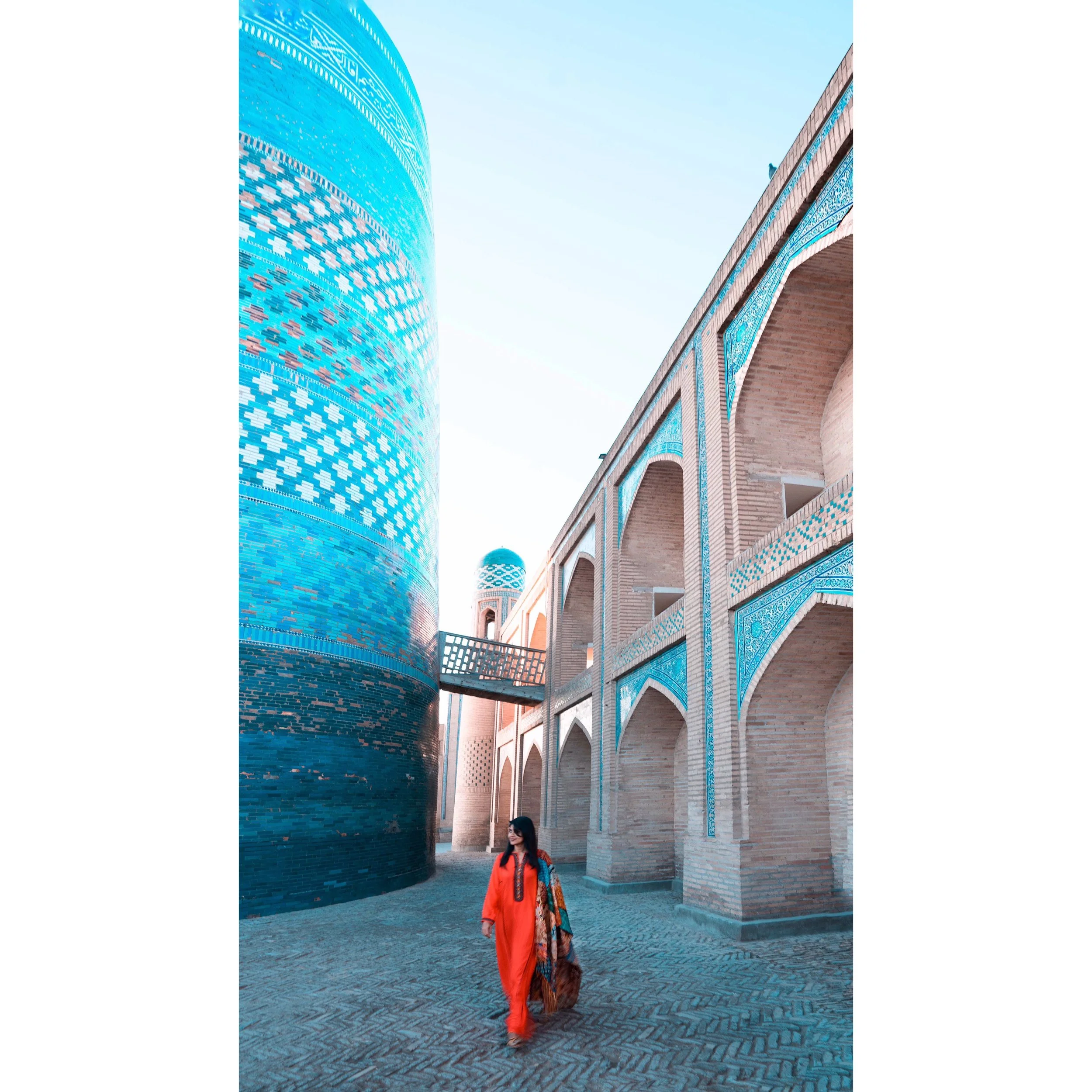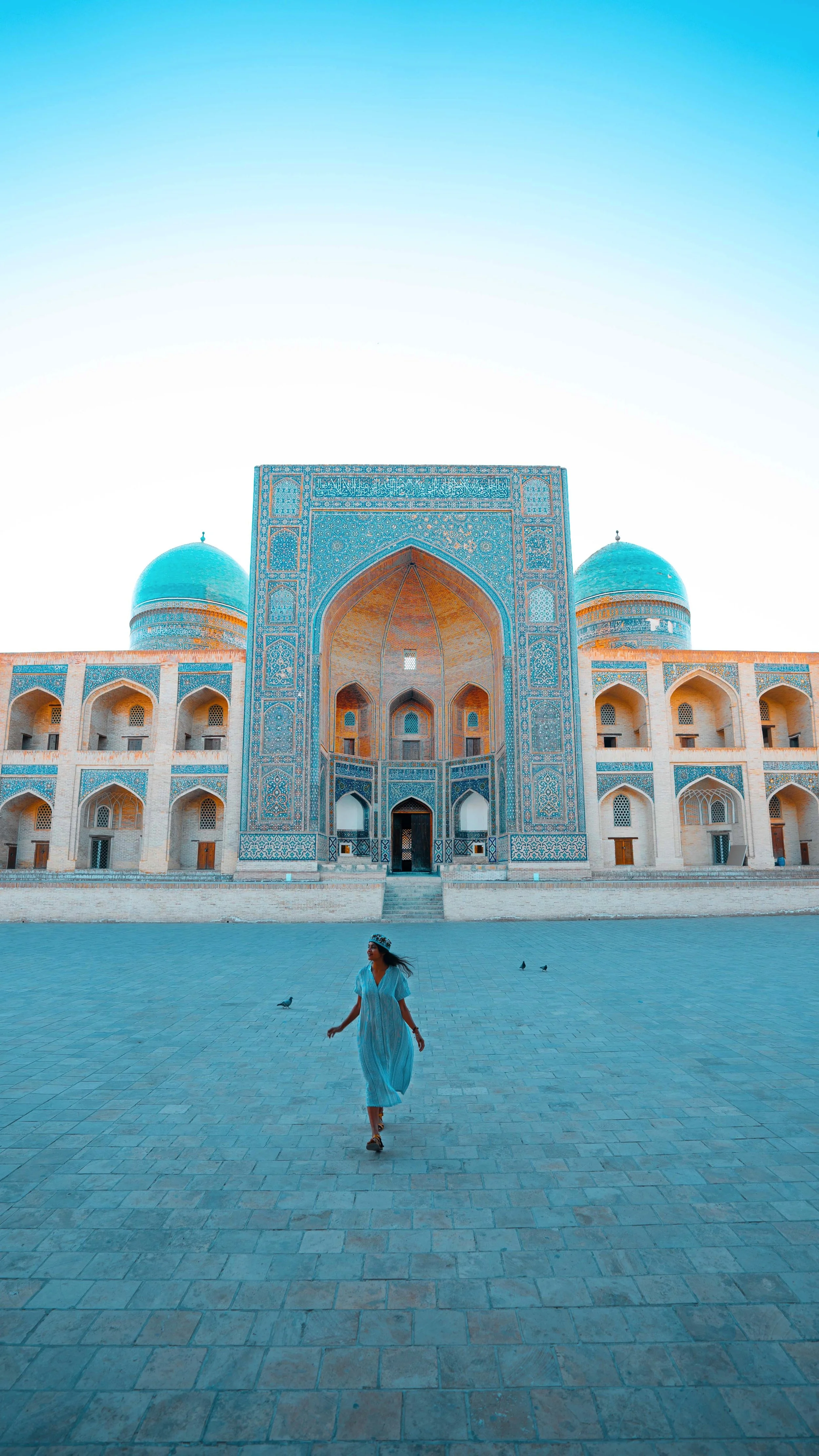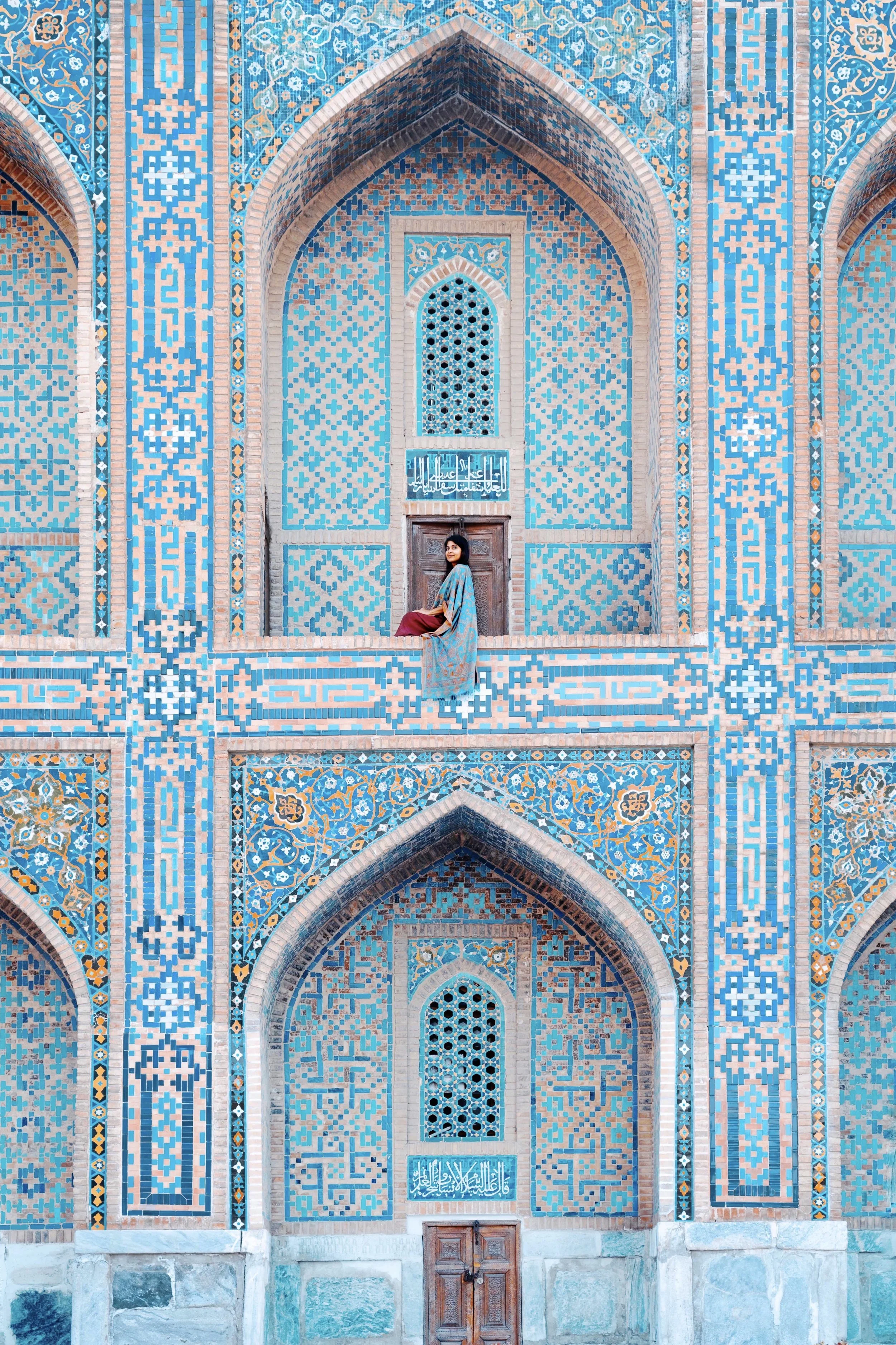The name Uzbekistan carries with it an air of mystery.
I recently had the spectacular opportunity to travel along the Silk Road with Acanela Expeditions, and when we traveled through the mysterious country of Uzbekistan, I was wowed by the history, culture, and people that we encountered. For those who have never heard of it, the Silk Road it is the ancient trade route that connected China to the West. During our trip along this iconic route, I was amazed to discover that three of the Silk Road’s most important cities lie in Uzbekistan: Khiva, Bukhara, and Samarkand. These cities were key stops for traders passing by with their caravans and camels loaded with silk, spices, and other items.
Today, Uzbekistan is opening up to tourists and making it easier for travelers to experience the splendor of the Silk Route — but you should get there quick, because this country is poised to receive lots more visitors in the coming years!
Bukhara: Po i Kalyan Complex
Getting to Uzbekistan
I flew Turkish Airways from San Francisco to Tashkent, the capital of Uzbekistan, with a stop-over in Istanbul airport. You can either arrange a pickup at Tashkent airport with your local hotel/hostel or grab a taxi to the city center, which should not be more than $5. Since I traveled with Acanela Expeditions, we had transportation waiting out for us at the airport and were whisked away seamlessly after immigration to our hotel.
Visas
There are many countries that do not require a visa, but for those that do, an e-visa (single, double, or multiple entry) is available through the e-visa portal. The system is fairly simple, but at first it wouldn’t accept my passport size photo. Acanela Expeditions resized it for me and I was then able to successfully submit it. I was then unable to process the visa fees in the next step, as the website link to “pay” was broken. Once again Acanela Expeditions reached out to the consulate and after several days of troubleshooting, I was able to make the payment successfully. Ironically, I received my e-visa in less than 24 hours from the time the payment went through!
Uzbekistan itinerary
I recommend approximately two days in Tashkent, two days in Khiva, three days in Bukhara, and another three in Samarkand, depending on how much time you have for your trip. You can arrive in Tashkent and take connecting trains to Bukhara and Samarkand. The trains are on time and equipped with AC, and tickets cost between $7-25, depending on when you reserve. Buy tickets in advance with a local Uzbek travel agency or buy tickets at the train station. To get to Khiva, fly from Tashkent to Urgench, and 30 minutes later you’ll find yourself in Khiva.
Tashkent
Tashkent is the largest city in Uzbekistan — a place where, 2,000 years ago, spice merchants and silk traders passed through the famous bazaars on their way to the West. Tashkent is a cosmopolitan city and home to Uzbeks, Kazakhs, descendents of Mongols, Tajiks, and other ethnicities. The people are predominantly Muslim, and due to the Soviet rule, the city still retains a Soviet flavor. Most people speak Uzbek and Russian. English is not spoken widely amongst the older generation, but I got by just fine with a lot of smiles and some creative sign language. I addressed the locals with “asalam alaykum” (a traditional greeting) and said thank you — “spaseeba” — in Russian, and this seemed to delight everyone into engaging with me!
Must-see places in Tashkent
Metro - The most practical way to travel in Tashkent is to go underground. The Soviet-designed metro is a work of art that crisscrosses the city. For the first time, you can now take photos inside the metro, which is a must, as every station is decorated beautifully with mosaics, chandeliers, space-themed ceilings, etc. You must buy a token from the kiosk underground before you travel; a single ride costs 1,200 soum. (I found it was pretty easy to hail a cab in Tashkent as well. Even though taxi drivers don’t necessarily all speak English, I would tell them the destination that they almost always seemed to recognize, and then we agreed on a random amount to pay at the end of the ride, which was always between $2-5.)
Chorsu Bazaar - In terms of bazaars located across Uzbekistan, Chorsu Bazaar is Tashkent’s oldest market. It’s easily identified by its big blue dome, which houses acres of produce, fruits, dried fruits, and nuts. You can find pistachios from Iran, dates from Saudi Arabia, and apricot kernels from Uzbekistan (which are delicious, especially the salted ones). I also found a section outside that carried fruits and vegetables, including the big flat bread. In the clothing and fabrics section of the market, you can find embroidered bags and beautiful Suzani embroidered throws.
Minor Mosque: This is a fairly new mosque and is also known as the white mosque for the color of its marble. While women cannot enter the mosque, men can use the circular prayer hall to pray. Noteworthy are the beautifully ornate mihrab, a niche indicating the direction of Mecca, and the ceiling.
Khast Imom Square: The spiritual heart of Tashkent for many centuries, today the square is a vast complex of religious sites such as the Barak Khan Medressa, the Hazrat Imam Mosque, and the small Muyi Mubarak Library (which holds the oldest Quran in the world). Barak Khan Madrasa is a 16th-century madrasa, located inside the Khast Imom Square. What used to be student rooms are now occupied by shops surrounding the central courtyard. I found some beautiful necklaces, locally made scarves, and miniature paintings, and I even observed an artist at work inside one of the workshops. Next to this madrasa is the Tellya Sheikh Mosque, which used to be Tashkent’s main place of worship.
TIP: Most hotels tend to collect your passports at the beginning of your stay, and you will likely need a passport and hotel registration slip to buy a SIM card. The internet has opened up quite a bit here in Uzbekistan, so WIFI at the hotels was not a problem.
Khiva
The walled town of Khiva is a delightful labyrinth of narrow mud-walled alleyways and stunning blue mosaics. Strolling around old town in the early morning, before the tourists arrive, is worth it because you will be able to truly experience the place in a very different way. I spotted an old woman baking bread in a traditional oven when I walked down one of the alleyways, and I also saw many brightly dressed cleaning ladies sweeping the dust on the streets and in front of the monuments. A single ticket, sold at the west gate, can be used to gain access to most of the city’s sights, and you can use this ticket for up to two days. The ticket costs approximately $6 per person, including a $1.90 camera fee. You will see many souvenir stalls in front of the monuments, giving you a chance to do some shopping for local items, but early mornings give you the opportunity to walk through these sights without the clutter of these shops.
Kalta Minor Minaret
Must-see places in Khiva
Itchan Kala: This is the inner town surrounded by brick walls some 30-odd feet (10 meters) high. Imagine, this used to be the last resting place of the merchants and caravans before crossing the desert to Iran. There are several outstanding structures here you should visit, like the Kalta-Minor Minaret, the Djuma Mosque, the mausoleums, the madrasas, and the two magnificent palaces built in the 19th century.
Tash Hauli: I loved visiting this palace that had some incredible tile work — including blue ceramic tiles, more than 150 rooms, and 9 courtyards.
Juma Mosque: Built in the 10th century around a small garden, the main chamber here is divided by 218 columns.
The Kalta-Minor Minaret: It’s a large, stubby, turquoise-tiled minaret, and legend has it that Mohammed Amin Khan who constructed it wanted to build a minaret so high that it could be seen all the way to Bukhara. But unfortunately the Khan dropped dead, leaving the beautifully tiled structure unfinished.
Isfandiyar Palace: I did not have time to visit this, but this palace is a quick, 10-minute walk outside the west gate, and it’s home to gold-embroidered ceilings and opulent chandeliers.
TIP: I had lunch at a local family’s home here inside the walled town, and it gave me such an incredible opportunity to connect deeper with the local Uzbeki people. I also got to learn how to make Dill pasta, which was surprisingly tasty. This is the advantage of traveling with a travel company like Acanela Expeditions that specializes in trips that help you connect with the locals. Alternatively, you can find guides online who can help you connect with local families as well.
Bukhara
Must-see places in Bukhara
Po i Kalyan Complex
Po I Kalyan Complex: My favorite structure to visit in Bukhara is the Po I Kalyan complex situated around the Kalon minaret. The Kalon mosque dates back to the 15th century. At sunrise, I caught some incredible sunburst shots inside the courtyard and had the chance to interact with local women who were coming to the mosque courtyard to meet with their friends.
The Ark of Bukhara: A massive fortress that was built and occupied around the fifth century AD, it’s now an archaeological museum. (TIP: Go up to the very top for the view of the city and its minarets.)
Bolo Haouz Mosque: This is a stunning mosque with 40 pillars (actually 20 are reflections in the pond in front). Don’t forget to look up at the entrance’s ceiling. The interior of the mosque is typical 18th-century Central Asian style — and it’s just gorgeous.
Lyabi Hauz Complex: This is where you go in the evenings for a stroll or for dinner. It’s a 17th-century square with music playing in the evenings and a lovely pond surrounded by restaurants.
TIP: To really go beyond the tourist sites, visit Abdullah, a sixth-generation ceramist who lives in Gijduvon, a small town 30-odd miles (50 kilometers) east of Bukhara. Visit his house, learn some pottery even, check out his studio, and discover how he’s reviving the ceramic art form, passed down from generations in his family.
BONUS TIP: Food is a great way to understand a local culture and form connections. So I visited a workshop in Bukhara by Rahman, an embroidery maker, who specializes in Suzani (needle work) embroidery. He also showed us how to make the national dish — Palov — with 15 spices in his beautiful kitchen courtyard. I ended up buying the most beautiful embroidered bag for my mom and an embroidered tree of life wall hanging.
Samarkand
Must-see places in Samarkand:
Registan Square
Registan: The most impressive sight in Samarkand is the Registan Square. The vast square is flanked by three large portals with inner courtyards. Each of the three portals has its own unique décor and inner courtyards. In the past, the square was the meeting point for all artisans and farmers selling their goods. The three madrasas in the square are: Ulughbek, Sherdor and Tilla-Kori. The Ulughbek portal’s inner courtyard has entrances to the student learning rooms which are now converted into shops. The Sher-Dor Madrasa’s inner courtyard also contains student rooms that now play host to a bazaar. The Tilla Kori Madrasa has a blue domed tower that belongs to the mosque to the left of the portal. Stepping into the inner courtyard, you will find the mosque to the left, and after you’re done admiring the incredibly stunning ceilings and interior, you can walk around through the souvenir stalls inside. I found myself an antique necklace and a beautifully designed local vase. Today different concerts, celebrations and events are held in this Registan square, don’t miss attending one if you get a chance.
Gur e Amir: This is the mausoleum of the Asian conqueror Timur (also known as Tamerlane). Believe it or not, this place actually served as the precursor and model for the later great Mughal architecture tombs, including the Taj Mahal in India, built by Timur’s descendants.
Shah I Zinda: it’s the most stunning avenue of mausoleums and the richest display of tile works I’ve ever seen.
The Siob Bazaar: Walking through here is delightful because I saw so many dried fruits and nuts I haven’t seen anywhere else. Don’t miss the dried apricot with stuffed raisins and walnuts!
TIP: Visit the Samarkand Silk Carpet Factory with co-founder and managing director Abdullah Badghisi and get ready for a treat. He will show you the silk worm cocoons and the dye process, then take you into his carpet-weaving workshop where you can meet the skilled female weavers behind the beautiful carpets. He has teamed up with the UN for a program that helps provide work for disadvantaged women in his factory. I ended up with a stunning silk shawl from the nearby Fergana Valley and a small carpet for my wall collection of carpets.
Weather and Clothing
The weather in May is a dream – hot during the day and perfect for evening strolls. September is also fantastic, as it doesn’t rain much during this period.
Although Uzbekistan is predominantly a Muslim country, it is not officially an Islamic nation. In the Soviet era, Uzbekistan was considered secular, and religion was not a priority. In terms of clothing, I tended to wear long skirts and dresses as I noticed people were dressed pretty modestly. You will see the older generation of women wearing head scarves and long, flowy, full-sleeved dresses, while the younger women wear jeans, skirts, and tops; I never saw anyone wearing shorts and tank tops. Headscarves are not required, nor did I see the younger generation wearing them.
Accommodations
Booking.com is my preferred website to check for accommodations which can be found in Uzbekistan for between $20-$30 a night.
Tashkent: Aster Hotel Group is a four-star hotel in Tashkent.
Khiva: Asia Hotel Khiva is where I stayed, and it was perfect as it was walking distance to old town. My room was pretty basic, and the bathroom didn’t have hot water that particular night, but the lobby and restaurant were beautiful.
Bukhara: Hotel Sasha & Son is a three-star hotel that reminded me of a riad in Morocco. It was cozy and decorated traditionally with an inner courtyard. The breakfast room was charming and cute. The rooms are spacious and lovely.
Samarkand: Emir Han is a four-star hotel and is farther away from the sights, but it boasts spacious rooms and a buffet breakfast that will get you through the day.
What to eat
I enjoyed the Uzbek cuisine very much and found it flavorful but oily. My favorite dish was the Plov that I tried in Tashkent, as well as in Bukhara in Rahman’s workshop. I also hogged on the local bread (naan or khorezm bread), shahlik, shivit oshi, and the delicious lagman noodles. The country’s zest for salads is surprising given their preference for meat, but I had some of the most delicious salads here.
Tashkent
The Plov Center: This is a fascinating place not to be missed. Walk through the courtyard and first gaze at the large vats of plov being prepared right in front of you. Once they plate the meal, it gets sent inside. Then you’ll walk into the restaurant and find yourself a table and get ready to enjoy your plov. This place is popular with locals.
Khiva
Terrassa Café: My favorite spot here is the Terrassa Café which has a stunning view over part of the city and is great for people watching and letting your imagination run wild about caravans and camels and silk!
Esaulboshi: An old caravanserai from the Silk Road, dinner here is lovely and traditional in a casual setting.
Bukhara
Chasmai-Mirob Restaurant: This is bang opposite the Po I Kalyan complex and is a fantastic spot to observe sunset over the complex while enjoying a meal.
Before this trip, I wasn’t really aware about Uzbekistan. But I discovered a corner of the world not crawling yet with tourists, where the locals are eager to engage and will gladly try to have a conversation with you through hand gestures. I discovered a country that’s a treasure trove of stunning monuments and immersive experiences that make a trip so memorable long after it’s over. To book this trip, visit Acanela Expeditions with yours truly as the host for September departure. Hope to see you there!
Written by Preethi Chandrasekhar




